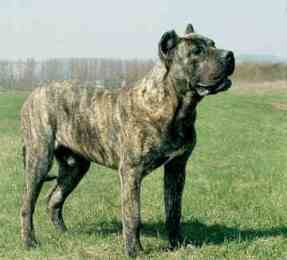
Presa Canario
- SIZE: 8
- GROOMING:: 7
- EXERCISE NEEDS: 8
- GOOD WITH DOGS: 1
- WATCHDOG: 9
- BREED: Presa Canario
- COLOR(S):Black, fawn, brindle with a dark brown or black mask.
DESCRIPTION
The Canary Dog ancestry probably includes the now extinct naive and indigenous Bardino Majero, crossed with imported English Mastiffs. It was developed in the Canary Islands in the 1800\'s specifically for dog fighting. At one time dog fighting was a common and popular entertainment in most European countries, and breeds were developed specially for their tenacity and endurance. In some countries, such as Ireland, fights were staged in open fields, but more often, as was the case in the Canary Islands, fighting took place in rings or pits. With the outlawing of dog-fighting on the island and the introduction of foreign dogs such as the German Shepherd Dog, by the 1960s the breed was nearly extinct. It was revived by the American veterinarian Dr. Carl Semencic. - See more at: http://www.puppiesndogs.com/breeds/presa-canario#sthash.bStDZniZ.dpufThe Canary Dog ancestry probably includes the now extinct naive and indigenous Bardino Majero, crossed with imported English Mastiffs. It was developed in the Canary Islands in the 1800\'s specifically for dog fighting. At one time dog fighting was a common and popular entertainment in most European countries, and breeds were developed specially for their tenacity and endurance. In some countries, such as Ireland, fights were staged in open fields, but more often, as was the case in the Canary Islands, fighting took place in rings or pits. With the outlawing of dog-fighting on the island and the introduction of foreign dogs such as the German Shepherd Dog, by the 1960s the breed was nearly extinct. It was revived by the American veterinarian Dr. Carl Semencic.
TEMPERAMENT
The Canary Dog requires a very dominant, experienced owner who understands the alpha nature in canines. The Canary Dog must know that his master is in control of him. No member of the family can be uncomfortable around the dog. Canaries make outstanding guard dogs. Their appearance is a deterrent not to mention their ability to confront any intruder. In the wrong hands this dog can be dangerous, but with the right owner it can make a nice, devoted companion. This is not a breed for first time dog owners. It is a very aggressive natured dog.
GROOMING
The short, rough coat is easy to groom. Brush with a firm bristle brush and wipe over with a piece of toweling or chamois for a gleaming finish. Bathe or dry shampoo when necessary. This breed is an average shedder.
HEALTH
Hip and elbow dysplasia is sometimes a problem, as well as entropion (inverted eyelids), epilepsy, demodectic mange, hypothyroidism, OCD, luxating patellas and wobbler syndrome.
EXERCISE
This breed only needs moderate exercise and little grooming. They are fairly easy to take care of. They should be walked moderately and brushed every week or so. They can be used in the urban household or as a helpful farmhand. They enjoy the outdoors, so a rural area would be best, although suburban areas can work with this breed. The best owner for this breed would be a dog-experienced family or individual living in a rural or suburban environment.
TRAINING
Although obedient, this breed must be trained when it is a pup. The owner must be a firm, consistent owner who can accept the challenge of training a puppy that is domineering and stubborn at times. They must be trained when they are young as they will become overly aggressive towards any stranger when they get older. Learning Rate: High. Obedience - Medium. Canary Dogs will obey their masters with obedience training, but can be dominant and not listen if not trained well. Problem Solving - High.


